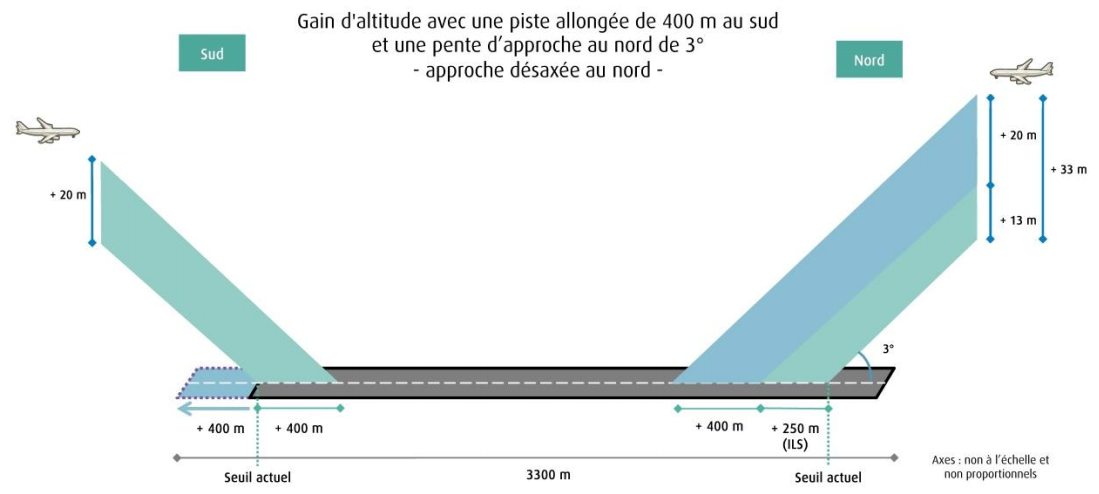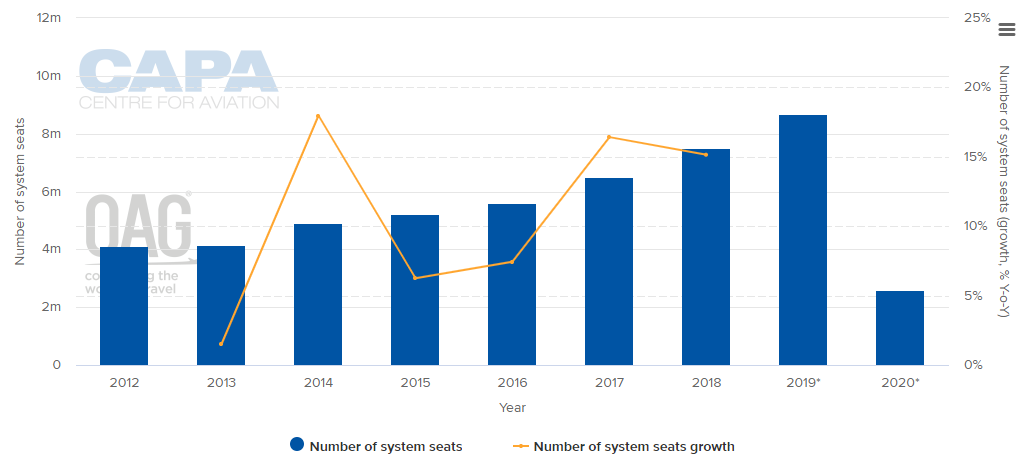While Nantes' runway will be extended 400m southwards to 3300m, overall operational length will decrease. The project includes offsetting the northern touchdown point 650m southwards, leading effectively to a net reduction in length of 250m and limiting the size of aircraft capable of being handled to those that currently operate at the facility.
The goal is to protect the more heavily populated residences in the airport's north around the city of Nantes, as well as limit the impact of the project on the municipality of Saint-Aignan-Grandlieu in the airport's south. A night curfew will be pushed back by an hour from 23:00 to 00:00 until 06:00 for louder aircraft types.
IMAGE - Adjustment of Nantes Airport's operational distance and approach conditions after a 400m extension will try to reduce noise pollution over the city of Nantes in the north Source: French Civil Aviation Authority
Source: French Civil Aviation Authority
Meanwhile, Mr Djebbari has stipulated that the current terminal will undergo "redevelopment", though this will also be only to a limited extent given the environmental and residential constraints. The aim will be to increase capacity to a meagre 11.4 million ppa by 2040, with financing to be made available to further expand the facility to 15 million should traffic prove higher than expected.
Works are scheduled to be carried out between 2020 and 2025 and will be financed and completed by the new concessionaire, a process which was tendered at the end of Oct-2019 and will be decided sometime in 1H2020.
Originally, the idea was for the Notre-Dame-des-Landes airport project to replace Nantes airport, creating a new international gateway for western France which would serve as a multi modal facility and transfer hub linking Nantes to Paris and the rest of France. Its location 30km northwest of Nantes, compared to the close proximity of the existing site to the city, would also have facilitated segmented expansion in the future if required.
CHART: System seat capacity at Nantes Atlantique airport has more than doubled from 2012 to 2019, with particularly strong growth over the last 12 months Source: CAPA - Centre for Aviation and OAG
Source: CAPA - Centre for Aviation and OAG
Like most mid-tier airports in Europe, Nantes airport has seen strong growth over the last decade, mainly driven by LCC activities of carriers such as easyJet, Transavia France and Volotea. Traffic has more than doubled between 2009 and 2018, with 6.2 million handled in 2018 and around seven million forecast for 2019.
The airport was not massively impacted by the dual demise of XL Airways France and Aigle Azur, other than losing two new routes to Guadeloupe and Martinique by XL that were planned for launch in 2020, so while seat capacity growth may start to slow in 2020, it can easily expect to reach seven million in 2019 and comfortably exceed the mark in 2020.
Looking ahead another 20 years, the government may be underestimating the potential for traffic growth and the need to expand infrastructure that is capable of absorbing this growth. The decision to abandon the project a year and a half ago in favour of expansion of the existing facility underlines the government's hesitation when it comes to capacity expansion and further highlights a lack of appetite for major infrastructure projects in Europe.
More importantly perhaps is the missed opportunity to develop Nantes airport's role as an alternative hub to Paris for trans-Atlantic traffic entering the Grand-Ouest region of France, encompassing regions such as Brittany, Pays de la Loire and Normandy, as the Notre-Dames-des Landes project once envisioned.
Ultimately, this new project will represent a huge investment for the future concessionaire for what is effectively a loss of runway length and a refurbished terminal.